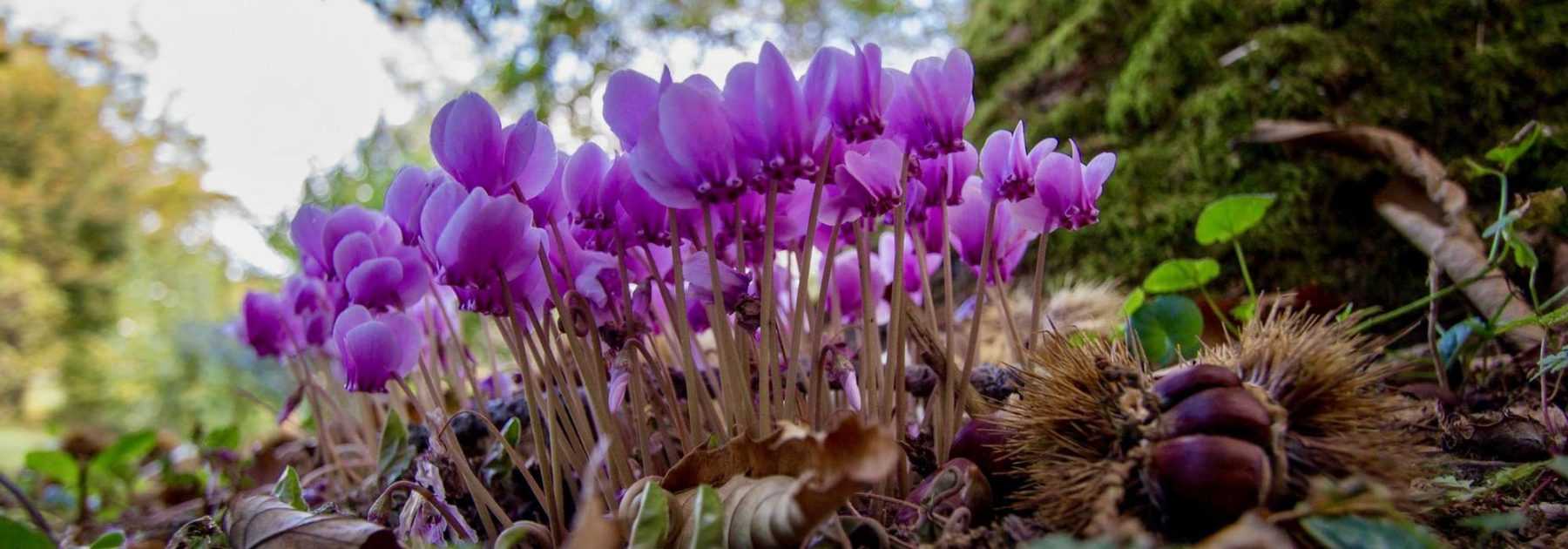
Cyclamen: Planting, Growing and Caring
Contents
Cyclamens in a nutshell
- Cyclamens are delightful little bulbous plants whose flowers bloom in late winter or late summer
- The foliage is just as decorative as the flowering
- In pots or borders, they thrive in shady spots
- Cyclamens naturalise easily to form beautiful coloured tapetum
Our expert's advice
Cyclamens are full of surprises beneath their delicate appearance. We adore their dainty, reflexed flowers that come in charming shades of pink, magenta or white, like little ballet dancers… But don’t be fooled by their looks: these are tough and very easy-to-grow plants. They thrive in partial shade, in areas that are often tricky to plant, and proudly brighten up the least floriferous months of the year.
Cyclamens are essential for bringing colour and freshness during the dull season. The beauty of their foliage alone justifies growing them: it offers lovely variations of green and silver patterns. Moreover, their elegant leaves provide winter shelter for beneficial garden insects.
Adaptable, they also delight urban gardeners: they grow very well in pots, indoors for florist’s cyclamen, or outdoors for other species, on balconies or terraces. They make delightful winter pot displays, adding splashes of colour against delicately variegated foliage. Endearing and graceful, cyclamens have undeniable charm!
Botany
Botanical data
- Latin name Cyclamen
- Family Primulaceae
- Common name cyclamen
- Flowering from August to May, depending on the variety
- Height from 10 cm to 35 cm
- Exposure partial shade or shade
- Soil type all well-drained soils
- Hardiness -15°C
Small perennial plants with a tubercle, cyclamen are among the easiest wildflowers to grow. Although native to Mediterranean countries, they thrive in any well-drained and fertile soil. Hardy, they can withstand temperatures down to -15°C, except for the more delicate Cyclamen persicum. They belong to the primrose family (Primulaceae), which includes herbaceous plants from temperate regions of the Northern Hemisphere.
The leaves are single, without stipules, and form a rosette at the base of the stem. The flower stalk is leafless. Cyclamen have fleshy, leathery foliage with prominent veins in lighter green, sometimes silvery. The underside is purplish-red, and the petiole is greenish-pink, creating a beautiful harmony of green, pink, purple, and silver.
The flowers come in a wide range of colours: red, magenta, pink, and white. They consist of five tepals reflexed backwards and fused at their base. At the centre, the flower may display a darker maculate, which is highly decorative.
The beauty of their foliage and flowers is undeniable, but their appeal also lies in the fact that they flower during the garden’s ‘quiet’ periods, from autumn through to spring.
The flowering period varies depending on the species. From January onwards, C. coum braves the cold to flower until March-April. C. pseudoibericum takes over from March to May (though the leaves have been present since the previous autumn). The Naples cyclamen blooms in late summer, from late August to September, followed by C. cilicicum from September to November.
Generally, the foliage is present in winter, displaying beautiful colours that are always welcome in a bare garden at this time of year. However, most cyclamen enter dormancy in summer and disappear during the hottest periods.
There are numerous species of cyclamen. Many are not very hardy and difficult to maintain, which is why only the coum, hederifolium, pseudoibericum, and cilicicum varieties are recommended for outdoor cultivation. Cyclamen persicum has produced many hybrids with larger flowers, but it is sensitive to cold and is best grown indoors.
After fertilisation, the flower stalk twists into a corkscrew shape towards the ground, creating amusing spirals at the base of the young plants. The seeds are coated with a mucilage that ants adore. The ants carry them to their nest and discard the naked seed once the sweet substance is consumed. Germination occurs within the year, and the seedlings will take 2 to 3 years to flower. This is how cyclamen gradually form vast and magnificent tapetums.
Over the years, the naturalised tubercle becomes enormous (as big as a plate!), producing increasingly large young plants. These bulbs do not produce bulblets and cannot be divided. Only sowing allows propagation. The tubercle is toxic.


Cyclamen foliage is highly decorative: Cyclamen hederifolium ‘Album’, Cyclamen coum, Cyclamen coum ‘Silver White’, Cyclamen neapolitanum.
Read also
How to sow cyclamen?The main varieties of cyclamen
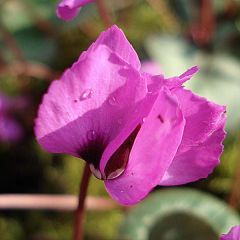
Cyclamen coum
- Flowering time March, April
- Height at maturity 10 cm
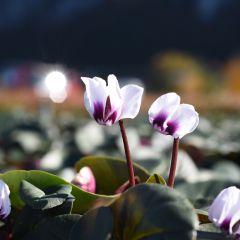
Cyclamen coum Album
- Flowering time March to May
- Height at maturity 10 cm

Cyclamen pseudibericum
- Flowering time February to April
- Height at maturity 15 cm
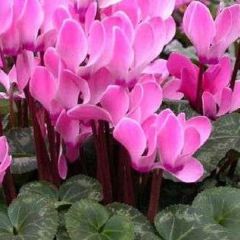
Cyclamen persicum - Persian Cyclamen
- Height at maturity 30 cm
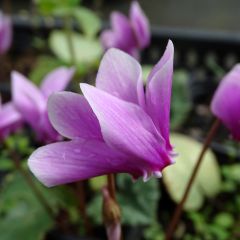
Pink Naples Cyclamen
- Flowering time September to November
- Height at maturity 15 cm
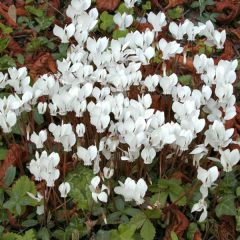
Cyclamen hederifolium Album
- Flowering time September to November
- Height at maturity 10 cm
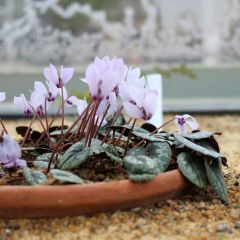
Cyclamen cilicium
- Flowering time October to December
- Height at maturity 10 cm

Cyclamen All The Year Round Flowering Mix - Garden Cyclamens
- Height at maturity 15 cm
Discover other Cyclamen
View all →Available in 1 sizes
Available in 4 sizes
Available in 1 sizes
Available in 3 sizes
Available in 1 sizes
Available in 1 sizes
Available in 1 sizes
Available in 1 sizes
Available in 1 sizes
Available in 1 sizes
Planting cyclamen
Cyclamens are available as young plants in buckets or as tubercles. The tubercle is flat, which may puzzle novice gardeners! To determine the correct planting orientation, examine the tubercle closely: you’ll notice a slightly rounded part, which should be placed facing downwards (so the flat side will be upwards…).
Where to plant cyclamens?
Cyclamens prefer shade or partial shade and well-drained soil, especially during their dormancy period, usually in summer. Any well-drained, humus-bearing soil will do. In a rockery, at the foot of deciduous trees or a hedge, even where few plants thrive, cyclamens will establish themselves permanently.
On a terrace or balcony, potted cyclamens should be placed in partial shade.
Indoors, place pots away from heat sources in a well-ventilated, bright room without direct sunlight.
When to plant cyclamens?
Plant cyclamen tubercles during summer, while they’re dormant. Young plants in buckets can be planted anytime except in mid-winter when the soil is frozen. If needed, soak dry tubercles in water for 10 minutes to rehydrate them.
In the ground
- Loosen the soil to 8-10 cm depth with a spade
- Add some compost and gravel, sand or pumice if planting in heavy, waterlogged summer soil
- Plant tubercles flat side up, 3-5 cm deep
- Water moderately
You’ll find detailed instructions on planting tubercles in the ground in this video.
In pots
For a 40 cm diameter pot, allow 2-3 tubercles. Soak young plants in buckets in water to improve establishment.
- Place crocks over the drainage hole
- Add gravel, pumice or clay pebbles to improve drainage
- Fill with potting compost
- Plant tubercles 3-5 cm deep (or pre-soaked young plants)
- Water moderately
Watch this video guide for planting bulbs in pots, and check our advice sheets: When and how to plant cyclamens? and How to grow Naples cyclamens in pots? Also discover our tutorial How to sow cyclamens?
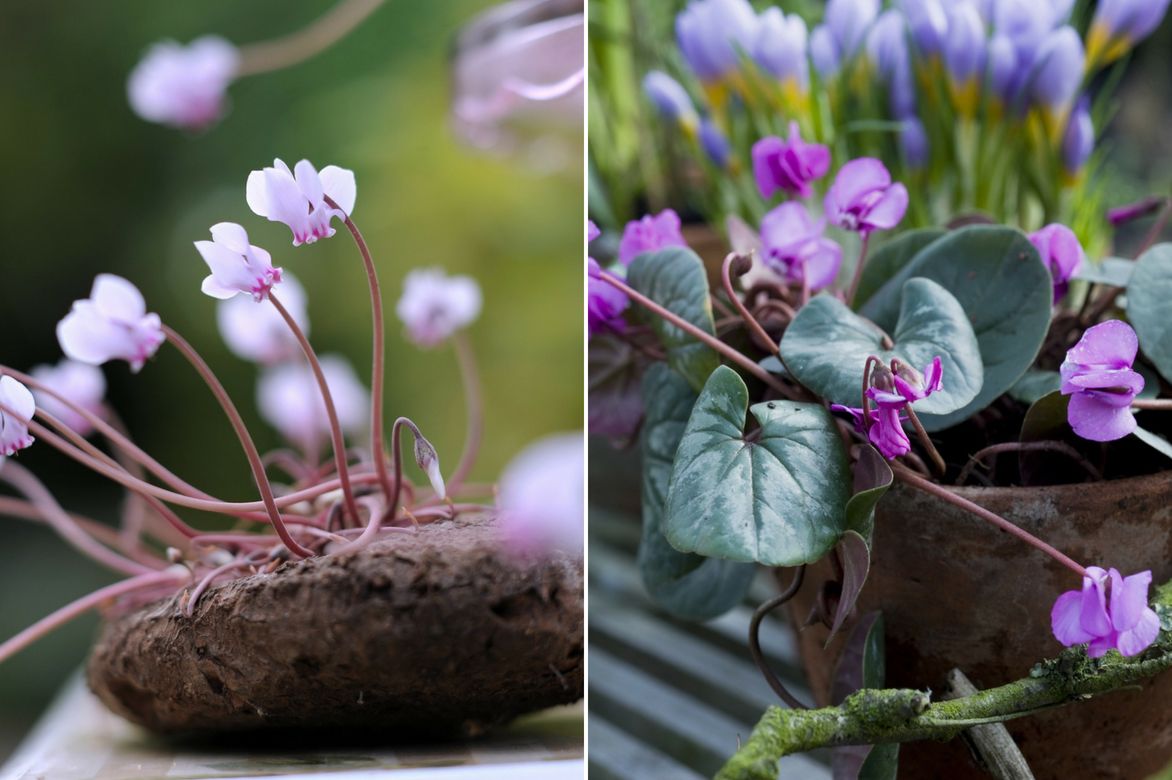
Flat Cyclamen tubercle / Potted Cyclamen (ibulb)
Cyclamen Care
Botanical cyclamens (coum, hederifolium…)
Very hardy, cyclamens planted in the garden require no special care. Careful planting, i.e. in light, well-draining soil that isn’t waterlogged in winter, will prevent tubercle rot.
In pots outdoors during winter drought, moderate watering is necessary. Wait until the substrate dries out and water at the base of the plant without wetting the leaves. When the bulbs enter dormancy, dig them up and dry them to store in a cool, dry place.
Cyclamen persicum and its hybrids
Moderate warmth around 18°C and a bright location should suffice to keep your cyclamen happy. As it’s an understory plant, avoid direct sunlight. Ideally, take it outside on frost-free days and bring it back in at night.
Moderate watering will be appreciated and removing spent flowers prolongs flowering. Gently pull the peduncle from the tubercle to prevent rot.
To prevent diseases, place the plant in a well-ventilated spot. Remove leaves at the first sign of wilting or yellowing.
Diseases and Pests
Outdoor cyclamen are hardy and not prone to diseases.
Florist’s cyclamen are susceptible to botrytis, or grey mould. A well-ventilated location prevents the spread of this fungus.
Fusarium wilt is equally devastating, attacking the tubercle and causing the leaves to yellow. A confined and warm atmosphere (25°C) encourages the proliferation of this fungus. An excess of nitrogen (such as fertiliser for green plants, for example) is just as harmful.
Propagation
Cyclamens spread easily through sowing. In nature, they colonise large areas thanks to their numerous seeds, also aided by the ants’ appetite. You can therefore collect the seeds and germinate them in buckets or sow them directly in place. They will quickly produce young seedlings which will only flower 2 or 3 years after sowing.
Association
Used as ground cover, in woodland settings or at the foot of a hedge, cyclamen can be paired with primroses or violas, small perennials that flower at the same time. Snowdrops or grape hyacinths will also make excellent companions.
For a fresh and vibrant effect, pair white cyclamen coum with yellow pansies, alongside white heather and a pale yellow hellebore – perfect for a balcony or rockery.
A lovely winter container idea is described in this short post by Ingrid.
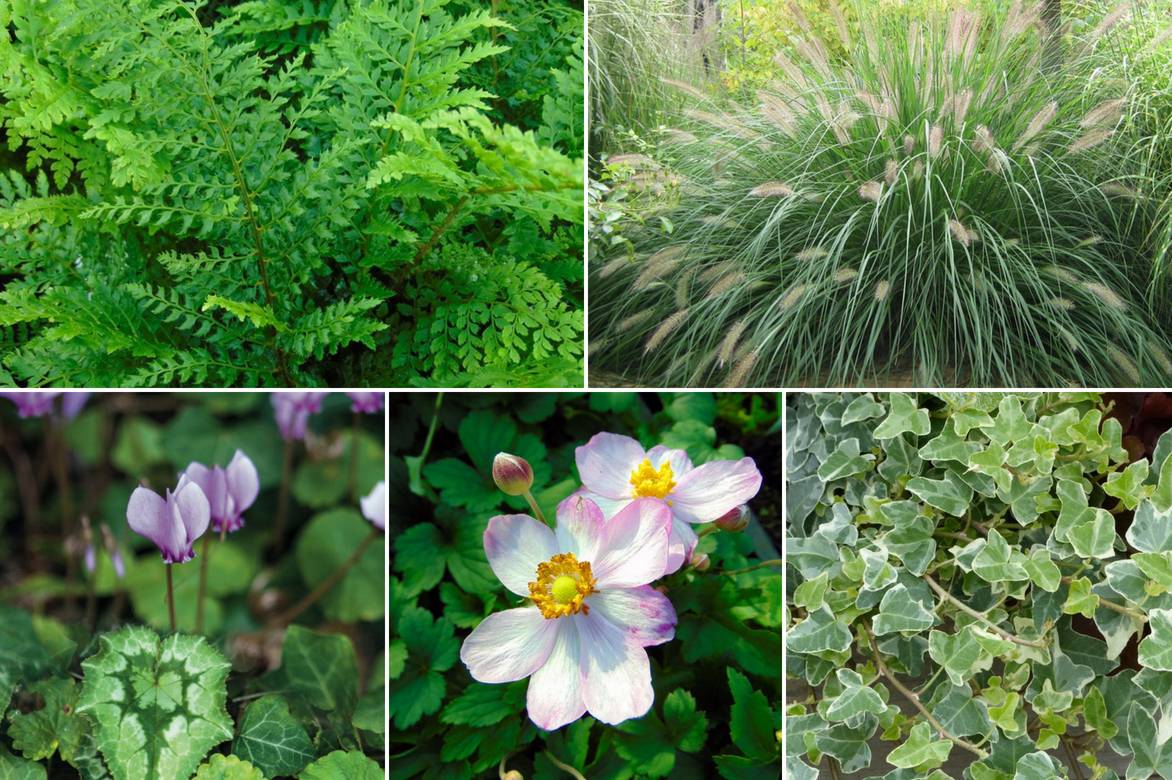

An example of a pairing in a large pot: Polystichum setiferum ‘Proliferum’, Pennisetum alopecuroides ‘Gelbstiel’, Cyclamen hederifolium, Anemone japonica ‘Fantasy Cinderella’, Hedera helix ‘Mini Ester’.
For autumn, dwarf asters and blue fescue will beautifully complement Naples cyclamen at their base.
Discover more plants to pair with your cyclamen in autumn and late winter.
Useful resources
- Discover our range of cyclamen!
- Discover our 7 ideas for creating beautiful summer planters
- Bulb sizing: understand to choose better
- Watch Olivier’s video on Cyclamen coum
- Our guide: how to grow Naples cyclamen in pots?
- Discover our ideas and inspiration for pairing cyclamen in the garden.
- Discover 7 bulbs for late summer to early autumn flowering
- Our guide: How to grow florist’s cyclamen?
- Marion’s advice in Brighten up shady areas with spring bulbs!
Frequently asked questions
-
I was given a flowering cyclamen. Should I put it outside?
You've likely been gifted a florist's cyclamen. As this variety is sensitive to cold, it's best kept indoors during frosty weather. Place it away from any heat sources and windows. Water moderately, avoiding wetting the leaves, and remove faded flower stems. It should flower from September to May! When the leaves disappear, the young plant is dormant. Store the pot in a cool, dry place and resume watering at the end of summer to see your cyclamen reappear. A small amount of low-nitrogen fertiliser once a month will maintain the flowering.
-
I have a potted cyclamen on my terrace windowsill that's been thriving for several years. It's grown so well that it's become enormous. I'd like to share it by dividing half into another pot. How do I divide my cyclamen?
Cyclamen tubercles should not be divided! To propagate them, collect the seeds and sow them in a bucket filled with seed compost. When the tubercle is very large, simply repot it into a larger pot, making sure to place the convex part of the bulb facing downwards (the flat side should always be on top).
-
I planted cyclamens for the first time at the end of last summer. Can I leave them in my garden all year round?
Cyclamens are hardy and can withstand low temperatures (down to -15°C). Towards the end of spring (a bit earlier for some varieties), cyclamens enter a dormant period for summer. They re-emerge in late summer, during autumn or winter, depending on the species. It's best to leave them in place to see them spread and enjoy their magnificent foliage and delicate flowerings.
- Subscribe!
- Contents
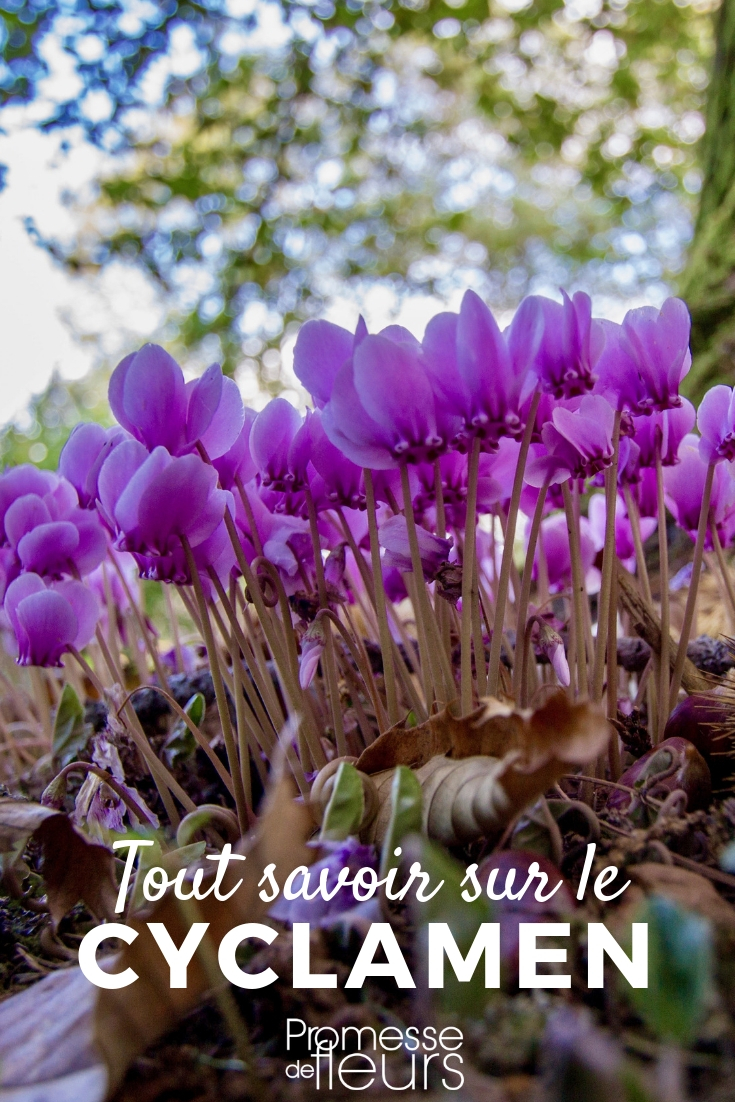

































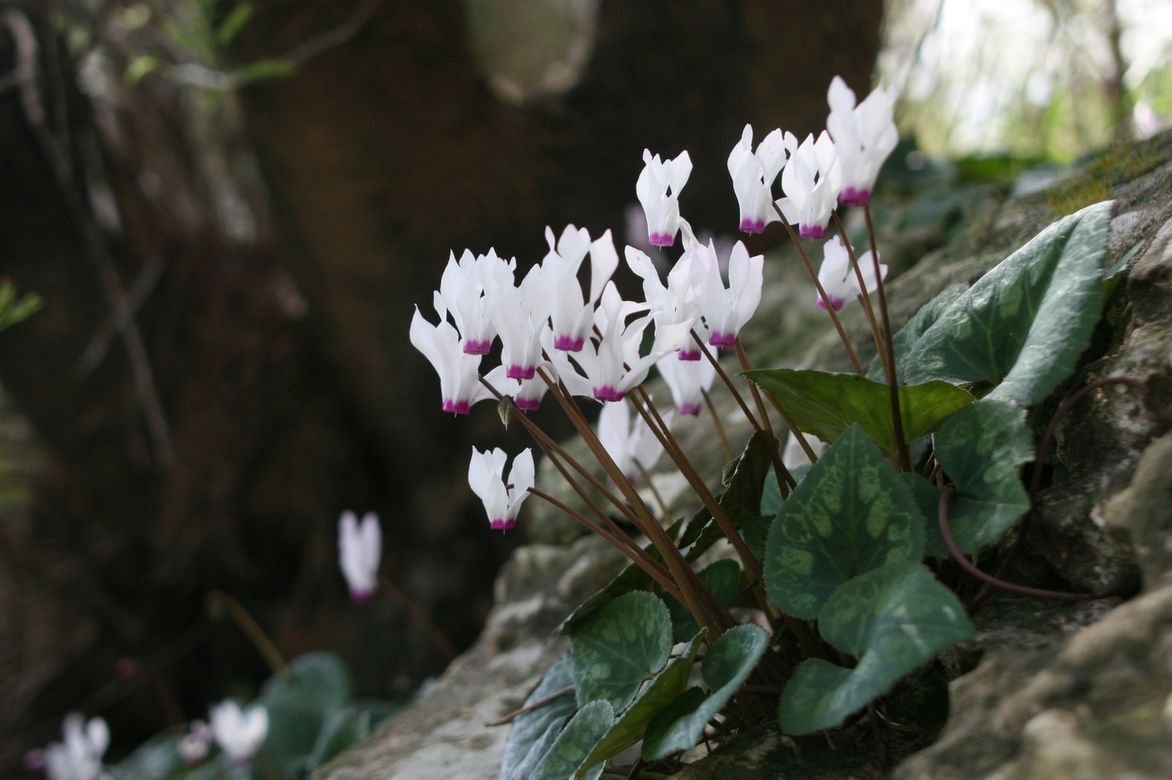

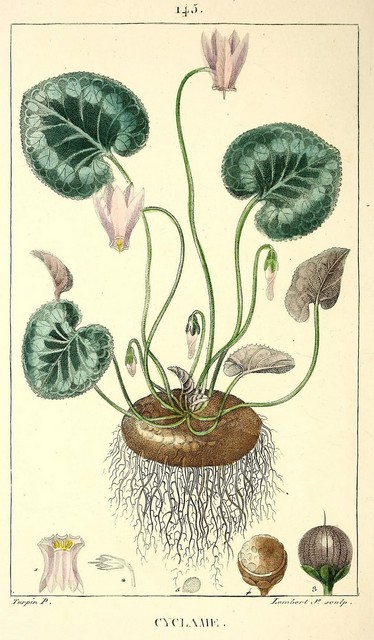



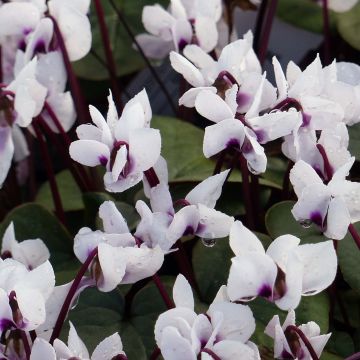
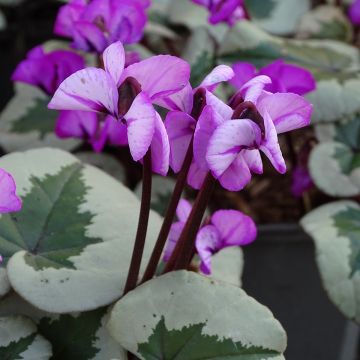
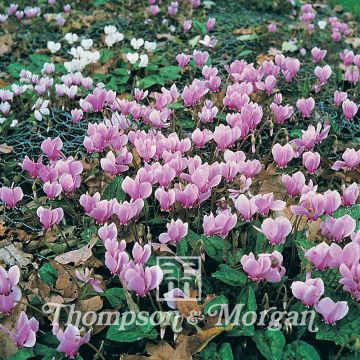
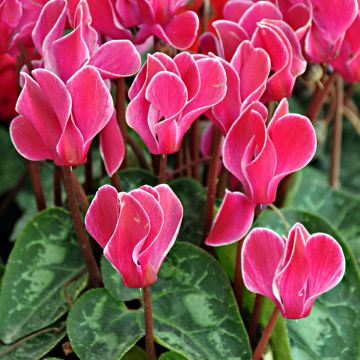

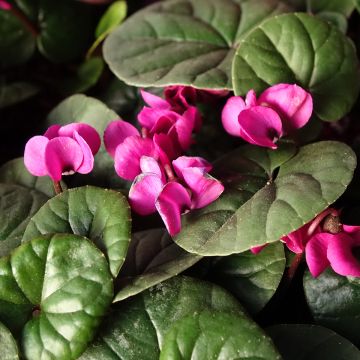
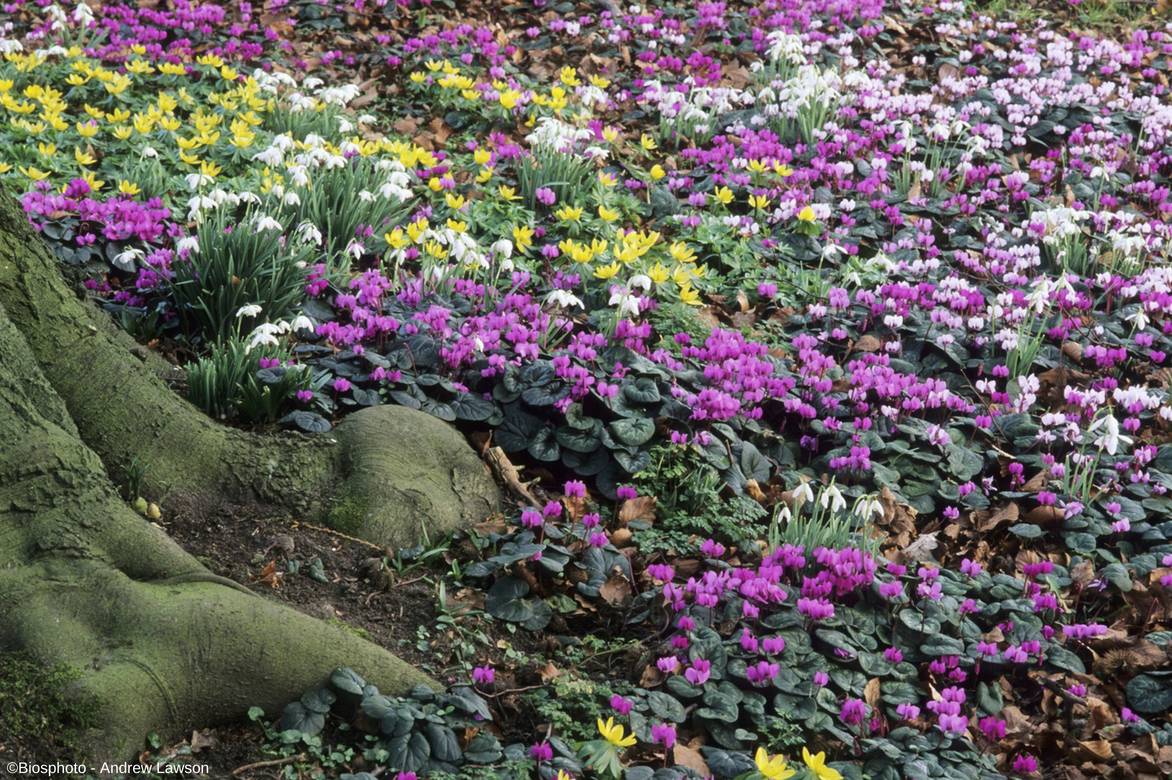
Comments